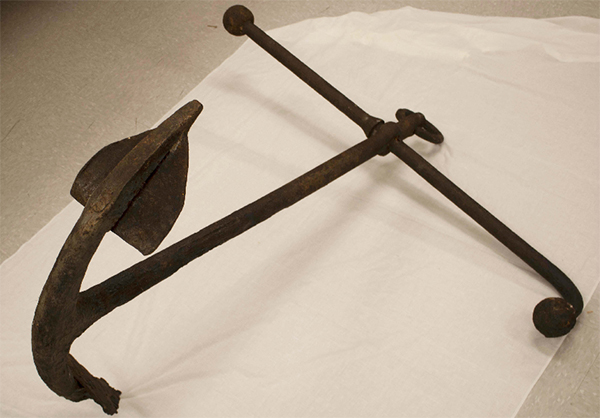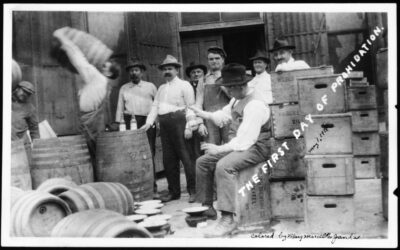
By David L. Bristow, Editor
Gloria Liljestrand-Barber found this four-foot-high, 100-pound anchor in 1985. It was mostly buried in a hayfield on her parents’ farm near Brady. A similar anchor had been discovered three miles away in 1894.
We don’t know what became of the 1894 anchor, but a few years ago Liljestrand-Barber donated this one to History Nebraska.
How did a heavy anchor come to rest in a central Nebraska hayfield? Here’s a clue: the Platte River is nearby.
Legend has it that the steamboat El Paso traveled up the Platte River in 1852, but the story never seemed plausible to most historians. Even shallow-draft steamboats of that era usually drew at least four feet of water, but the Platte’s braided channels were frustrating even in fur trade-era canoes or bullboats.
But how else do you explain these heavy anchors? Turns out the Platte River has another anchor story from the mid-1800s, and it’s not what you might expect.
———
The story of the El Paso’s purported Platte River voyage begins with a man named Edward Everett Hale, an author, historian, and Unitarian minister who in 1854 wrote Kanzas (sic) and Nebraska, a hastily-compiled promotional book for prospective settlers. In it, Hale claimed that the steamboat El Paso had ascended the Platte River more than 500 miles in the spring of 1853, following the North Platte River to a place somewhere above Fort Laramie in present-day Wyoming. Hale didn’t say where he heard the story.
In 1921 Nebraska historian Grant Lee Shumway elaborated on the story in his History of Western Nebraska. Shumway claimed that the voyage took place in 1852, and that the El Paso reached Fort Mitchell near Scotts Bluff and continued upstream to the site of present-day Guernsey Dam in Wyoming. But Shumway didn’t cite any sources, nor could he remember any when Nebraska State Historical Society superintendent Addison Sheldon later asked him about it.
But the story continued to spread, repeated as fact in other articles and books. Historian William E. Lass finally debunked it in a 2008 article for Nebraska History Magazine.
Lass showed that the El Paso was a real Missouri River steamboat, a 260-ton sidewheeler that measured 174 feet long and 26 feet wide. (Try to picture that next time you cross the Platte!) But he also showed that the boat’s whereabouts were well documented in 1852 and 1853–and the El Paso was never on the Platte. As for Fort Mitchell, its purported destination, that army post wasn’t even built for another twelve years. There was simply no financial incentive for such an expensive and hazardous journey when there was money to be made on the busy Missouri River.
A Platte journey made no better sense in terms of logistics. The El Paso’s wood-fired boilers would have consumed about 1.25 cords per hour. Steamboats normally refueled several times per day, but there were no commercial woodyards along the Platte. And stockpiling wood on deck would only settle the boat deeper into the shallow water.
Lass also drew attention to the absence of eyewitness accounts. Thousands of emigrants were traveling along the Platte River Road in those years, but steamboat sightings–surely a noteworthy event in such a location–appear neither in the hundreds of surviving trail diaries, nor in the official records of Forts Kearny and Laramie.
But what about other steamboats in other years? Lass explains that “the Platte was a braided river with many channels intersected by islands” and that it has a tendency “to widen rather than deepen during its most vigorous flows.” If there’s any place on the Platte where a steamboat might have a chance, it would be on the lower (eastern) part of the river. In 1855 the Mary Cole, a 93-ton sidewheel ferry (about half the size of the El Paso) tried to ascend the Platte but grounded before reaching the mouth of the Elkhorn. Other documented attempts by small steamboats on the lower Platte similarly failed.
So how did two heavy, mid-nineteenth century steamboat anchors end up near Brady?
———
“General O’Brien is building a pontoon bridge across the Platte opposite Cottonwood, 100 miles west of Kearney, where the overland stage line will connect with the railroad until next spring, or until the railroad reaches Alkali or Julesburg.” – Kearney Herald, Nov. 17, 1866
By 1866, the Union Pacific Railroad was rapidly laying tracks westward toward an eventual junction with the eastbound Central Pacific tracks–the nation’s first transcontinental railroad. The railroad followed the Platte Valley, the same route long used by westbound emigrants of the Oregon, California, and Mormon trails.
In 1863 the 7th Iowa Cavalry, commanded by Gen. George O’Brien, built a fort popularly known as Fort Cottonwood and later officially named Fort McPherson. It stood not far from the Platte River about ten miles southeast of present-day North Platte.
No bridges spanned the Platte River in those days. It was possible (though risky) to ford the shallow channels in some places, but the river was a major barrier to north-south travel.
What did an 1860s pontoon bridge look like? The Army used many pontoon bridges during the Civil War. Peter Glyer explains how they were built at his Mercer Square blog. As an illustration, Glyer includes this painting from the National Park Service Visitor Center at Fredericksburg. Notice the anchors:

The Platte River pontoon bridge didn’t necessarily look exactly like this, but this is the apparent reason for the two anchors that Nebraskans discovered. (And there may be others.)
The Nebraska anchors, in other words, tell a story not of steamboat travel on the Platte, but of the transcontinental railroad and of stagecoaches, freight wagons, and other traffic along the Great Platte River Road. And because nearby Fort McPherson was involved in military campaigns during the Indian Wars, the anchors also speak to the conquest of the Plains and the dispossession of Native tribes.
That’s not the story you expect when you see a boat anchor, but that’s one of the things that makes history so interesting. Artifacts often tell multiple stories, and sometimes those stories are far from obvious at first glance.
Posted April 5, 2023. Ben Kruse also contributed research to this article.
Sources:
William E. Lass, “The Mythical Platte River Voyage of the Steamboat El Paso,” Nebraska History 89 (2008): 54-66.
Donald D. Brand, “Navigation of the North Platte,” The History of Scotts Bluff Nebraska, Field Division of Education, National Park Service, Oct. 20, 2001. https://www.nps.gov/parkhistory/online_books/berkeley/brand1/brand1h.htm
Peter Glyer, “Engineers on the Rappahannock (Part 3) – How to Build a Pontoon Bridge,” Mercer Square, June 26, 2019, https://mercersquare.wordpress.com/2019/06/26/engineers-on-the-rappahannock-part-3-how-to-build-a-pontoon-bridge/
Rick Warner, “Adrift on the Prairies: Old Anchor Rekindles Nebraska Mystery,” Associated Press, Nov. 26, 1985. https://apnews.com/article/5529b767b01067aedaf9bfc9f6445466




